
Rocking stone
Encyclopedia
Rocking stones are large stones
that are so finely balanced that the application of just a small force causes them to rock. They are found throughout the world. Some are man-made megalith
s, but others are natural, often left by glacier
s.
Logan or rocking stones are known in Scotland
sometimes as clach-bràth. They marked locations where Scottish open-air court
s would take place. A clach-bràth is sometimes known as a judgment stone. The reason that courts were near logan stones is that the movement of stones in such formations was used to determine the guilt or innocence of those accused of serious crimes in ancient times.
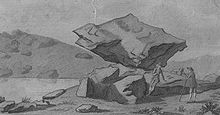 The word "logan" is probably derived from the word "log", which in an English dialect means to rock. In fact, in some parts of the UK, rocking stones or logan stones are called logging stones. The word "log" might be connected with the Danish word "logre", which means to "wag a tail".
The word "logan" is probably derived from the word "log", which in an English dialect means to rock. In fact, in some parts of the UK, rocking stones or logan stones are called logging stones. The word "log" might be connected with the Danish word "logre", which means to "wag a tail".
Some have suggested that the word "logan" comes from a Cornish
expression for the movement that someone makes when inebriated. Davies Gilbert
writes:
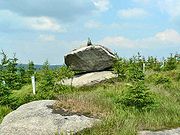
s, so situated that the least touch can make them rock in one certain direction, but which cannot be made to move in any other by all the force that can be applied to them by unaided human
s. Such stones are common in Britain
and other places around the world; in Galicia, they are called pedras de abalar
.
Pliny the Elder
(23-79) wrote about a rock near Harpasa
(in Caria
, Asia Minor) that could be moved with a finger but could not be dislodged with a thrust of the whole body. Ptolemy
(ca. 90 – ca. 168) wrote about the Gygonian rock, which he claimed could be moved by pushing on it with the stalk of an asphodel
, but could not be removed by any force.
There are stones in Iona
called na clachan-bràth, within the precincts of a burial ground, and placed on the pedestal of a cross, and have been according to Pennant
, the supports of a tomb
.
 There is a massive 90 - 95 ton glacial erratic boulder near Halifax, Nova Scotia which can still be rocked with a lever but which used to move quite easily, before a band of sailors from the nearby Halifax garrison rocked it into a more stable configuration in the 1890s, and before its base was worn down by excessive rocking in the 1980s and 90s when a park was developed around it at Kidston Lake
There is a massive 90 - 95 ton glacial erratic boulder near Halifax, Nova Scotia which can still be rocked with a lever but which used to move quite easily, before a band of sailors from the nearby Halifax garrison rocked it into a more stable configuration in the 1890s, and before its base was worn down by excessive rocking in the 1980s and 90s when a park was developed around it at Kidston Lake
, in the Spryfield area of the municipality. It used to be a popular picnic destination: in Victorian times: people would travel from Halifax, climb upon it and spread their lunches, while enjoying the sensation of rocking gently while seated upon the huge rock.
There is a rocking stone in Pontypridd
in Wales
in the middle of a Druid
ic stone circle.
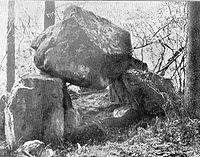 Bosistow Logan Rock is at the head of Pendower Cove (sometimes written as Pendour Cove) near Zennor
Bosistow Logan Rock is at the head of Pendower Cove (sometimes written as Pendour Cove) near Zennor
, Cornwall
. It apparently was discovered by an employee of the lord of the local manor whose duty it was to watch the coast. A ship had been wrecked in the cove, and while watching ensuing activity, the employee leaned against a boulder. Suddenly there was a gust of wind, and the boulder shifted, or "logged". The longest side of this mass of stone is about 15 feet (4.6 m), and the circumference of its biggest end is about 20 feet (6.1 m). It is thought to be about 20 tons.
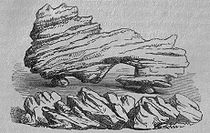 A rocking stone is recorded near the site of Saint Bride's Chapel. This stone stands on top of the Craigs of Kyle near Coylton in Ayrshire. It weighs around 30 tons and rests upon two stones. A large standing stone known as Wallace's stone stands nearby.
A rocking stone is recorded near the site of Saint Bride's Chapel. This stone stands on top of the Craigs of Kyle near Coylton in Ayrshire. It weighs around 30 tons and rests upon two stones. A large standing stone known as Wallace's stone stands nearby.
There is a rocking stone near Loch Riecawr in South Ayrshire
.
In the parish of North Carrick
in the Straiton District
in South Ayrshire
,
about a quarter of a mile to the west of the White Laise, and near the March Dyke, there is a rocking stone named the Logan Stone. The Logan Stone is a gray granite rock and rests on graywacke, and can easily be moved with one hand. It is 4 in 3 in (1.3 m) by 4 feet (1.2 m), by 3 foot (0.9144 m) high.
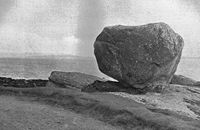 Near Lugar in the Parish of Auchinleck in Ayrshire, Scotland is a rocking stone in a hollow by the Bella Water near its junction with the Glenmore Water. It is made of two vertical stones, and a horizontal stone about six feet long, three feet broad and four feet high. It was regarded as a Druid
Near Lugar in the Parish of Auchinleck in Ayrshire, Scotland is a rocking stone in a hollow by the Bella Water near its junction with the Glenmore Water. It is made of two vertical stones, and a horizontal stone about six feet long, three feet broad and four feet high. It was regarded as a Druid
ical monument or the grave of a Caledonian hero.
A rocking stone existed in 1913 - 1919 at Sannox on Arran. It sat on a nearly horizontal platform next to the seashore.
The Kyaiktiyo Pagoda
in Burma is a religious shrine built on top of a huge granite boulder that is also a rocking stone.
There are even some masses that have been shaped by humans that exhibit similar behavior (sometimes unintentionally). For example, in the ruins of the Roman temples at Jerash
in Jordan
(the "city of 1000 pillars"), there are some massive pillars that move back and forth in the slightest breeze.
in West Yorkshire
. It had already ceased to rock when described by John Watson
in 1775
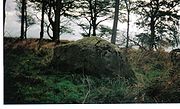
 Ayrshire
Ayrshire
in Southwest Scotland apparently is endowed with a geology that lends itself towards the formation of rocking stones. There are several rocking stones, or stones that used to rock at one time, in Ayrshire.
A rocking stone that some associate with the Druid
s is on Cuff Hill in Hessilhead
, near Beith
in North Ayrshire
. It no longer rocks due to people digging beneath to ascertain its fulcrum. It is in a small wood and surrounded by a circular drystone wall.
The Ogrestone or Thurgartstone
near Dunlop
in East Ayrshire
is thought to have been a rocking stone. However soil has built up around the base of the Thurgatstone over the years, which now prevents any rocking motion.
The Lamagee or Lamargle stone is in the center of a stone circle in the village of Lugar
in East Ayrshire
. The Lamargle stone rests on two stones. Local legend has it that the Lamargle stone used to rock, but it no longer does.
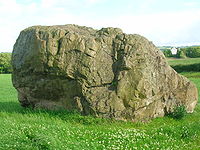
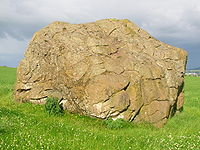 The Clochoderick stone near Howwood
The Clochoderick stone near Howwood
and Kilbarchan
in Renfrewshire
used to rock and it is said that the Druids used it to judge people. The accused was made to sit on the stone and by the way it moved the Druids judged the innocence or guilt of the individual. It is also said to be the burial place of Rhydderch Hael, King of Strathclyde who was the victor at the Battle of Arderydd near Arthuret in the Borders. His victory brought Christianity to Strathclyde. This stone is very unusual and is a SSSI for Geology in its own right.
near Lustleigh
on Dartmoor
. It was also called 'The Nutcrackers stone' sometimes seen on Ordnance Survey
maps. The huge stone once lay overhanging Lustleigh Cleave until 1951 when vandals pushed the stone down the valley. A failed attempt to rescue the stone, by pulling it back up the valley resulted in it breaking into pieces.
, which is described in Gibson
’s edition of Camden’s ‘Britannia'
, from a manuscript account by George Owen:
Cromwell
’s soldiers rendered the rocking-stone of Pembrokeshire immovable after Mr. Owen had described it. They reportedly destroyed it because they felt it encouraged superstition.
in Yorkshire
. However, the Golcar Hill rocking stone will no longer easily rock because some masons wanted to find out how such a large weight could move so easily, so they chopped at it until they destroyed its balance.
, near Pendennis
, Cornwall
. It is 11 feet (3.4 m) long, 4 feet (1.2 m) deep, and 6 feet (1.8 m) wide. It was toppled by Shrubsall, the governor of Pendennis, and his men about 1650 during Cromwell
’s Commonwealth. One rumored motivation for the dislodging was a purported prophecy of Merlin
. Merlin had supposedly said that Men Amber would stand until England had no king.
Rev. Dr. William Stukeley
wrote
William Borlase
in his 1754 book Antiquities of Cornwall, claimed that Men Amber was dislodged because:
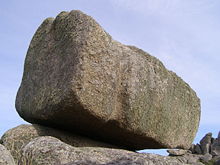 Another well-known example of a rocking or logan stone is Logan Rock
Another well-known example of a rocking or logan stone is Logan Rock
of Treen in Cornwall
. This huge stone weighs about 80 or 90 tons. It is one of the best known rocking stones for several reasons. For example, Modred, in William Mason
's dramatic poem "Caractacus," addressing the characters Vellinus and Elidurus, says of the Logan Rock:
However, another reason that the Logan Rock of Treen is remembered is that it was the center of a famous drama. In April 1824, Lieutenant Hugh Goldsmith, R. N. (nephew of the famous poet Oliver Goldsmith
), and ten or twelve of his crew of the cutter HMS Nimble, armed with bars and levers rocked the huge granite boulder until it fell from its cliff-top perch. Goldsmith was apparently motivated to disprove the claim of Dr. Borlase
, who wrote in Antiquities of Cornwall in 1754 that:
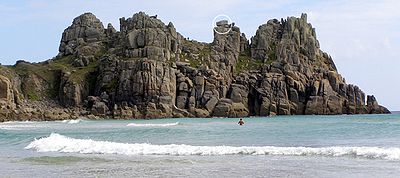 Goldsmith was determined to demonstrate that nothing was impossible when the courage and skill of British seamen were engaged. The Logan Rock fell and was caught in a narrow chasm.
Goldsmith was determined to demonstrate that nothing was impossible when the courage and skill of British seamen were engaged. The Logan Rock fell and was caught in a narrow chasm.
This upset the local residents considerably, since Logan Rock had been used to draw tourists to the area. Sir Richard R. Vyvyan (1800-1879) was particularly unhappy. They demanded that the British Admiralty strip Lieutenant Goldsmith of his Royal Navy commission unless he restored the boulder to its previous position at his own expense. However, Mr. Davies Gilbert
, persuaded the Lords of the Admiralty to lend Lieutenant Goldsmith the required apparatus for replacing the Logan Rock. The Admiralty sent thirteen captains with blocks and chains from the dock yard at Plymouth
, and contributed £25 towards expenses. Gilbert also raised more funds
 After months of effort, at 4.20pm on Tuesday, the 2nd of November, 1824, in front of thousands of spectators and with the help of more than sixty men and block and tackle, the Logan Rock was finally repositioned and returned to "rocking condition" (Michell 1974). Apparently the total final cost of this enterprise was £130 8s 6d. However, it is not clear how much of the remaining £105 Goldsmith had to make up out of his own pocket.
After months of effort, at 4.20pm on Tuesday, the 2nd of November, 1824, in front of thousands of spectators and with the help of more than sixty men and block and tackle, the Logan Rock was finally repositioned and returned to "rocking condition" (Michell 1974). Apparently the total final cost of this enterprise was £130 8s 6d. However, it is not clear how much of the remaining £105 Goldsmith had to make up out of his own pocket.
For some time after, the rock was kept chained and padlocked, but eventually these restrictions were removed, and the rock was set free. However, it apparently no longer vibrates or "logs" as easily as it did before.
Tourism dropped, and this was blamed on the condition of Logan Rock. For a while, Treen was nicknamed 'Goldsmith's Deserted Village'.
Another famous rock structure, Lanyon Cromlech, was knocked down during a thunderstorm in 1815. The same machinery that was used to restore the Logan Rock in Treen was successful in repositioning Lanyon Cromlech.
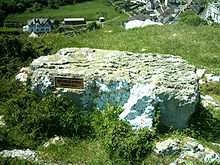 There are a wide variety of beliefs associated with rocking stones. Because of their strange nature, rocking stones were sometimes associated with witchcraft
There are a wide variety of beliefs associated with rocking stones. Because of their strange nature, rocking stones were sometimes associated with witchcraft
, or Druids. Stones which
were balanced so that the wind could move them were used sometimes in trials to determine guilt or innocence of the accused.
It was said that the rocking stone near Nancledrea
in Cornwall
could only be moved at midnight when witches were out. People claimed that if you touched the rocking stone nine times at midnight, you would turn into a witch.
The Brimham rocking stone in Yorkshire
is said to rock only for the efforts of an honest man.
The rocking stone at Land's End
was said to have been placed there by a giant who used it to rock himself to sleep.
It was claimed that the Logan Stone
in Treen could cure childhood diseases. The children were rocked on the Logan Stone in certain seasons. People say that the charm was broken when Lieutenant Goldsmith dislodged the Logan Stone.
It is a Cornish tradition to make a vow and then attempt to move a rocking stone, or logan rock. It was said that no one with treachery in their heart could make a rocking stone move.
Rock (geology)
In geology, rock or stone is a naturally occurring solid aggregate of minerals and/or mineraloids.The Earth's outer solid layer, the lithosphere, is made of rock. In general rocks are of three types, namely, igneous, sedimentary, and metamorphic...
that are so finely balanced that the application of just a small force causes them to rock. They are found throughout the world. Some are man-made megalith
Megalith
A megalith is a large stone that has been used to construct a structure or monument, either alone or together with other stones. Megalithic describes structures made of such large stones, utilizing an interlocking system without the use of mortar or cement.The word 'megalith' comes from the Ancient...
s, but others are natural, often left by glacier
Glacier
A glacier is a large persistent body of ice that forms where the accumulation of snow exceeds its ablation over many years, often centuries. At least 0.1 km² in area and 50 m thick, but often much larger, a glacier slowly deforms and flows due to stresses induced by its weight...
s.
Logan or rocking stones are known in Scotland
Scotland
Scotland is a country that is part of the United Kingdom. Occupying the northern third of the island of Great Britain, it shares a border with England to the south and is bounded by the North Sea to the east, the Atlantic Ocean to the north and west, and the North Channel and Irish Sea to the...
sometimes as clach-bràth. They marked locations where Scottish open-air court
Court
A court is a form of tribunal, often a governmental institution, with the authority to adjudicate legal disputes between parties and carry out the administration of justice in civil, criminal, and administrative matters in accordance with the rule of law...
s would take place. A clach-bràth is sometimes known as a judgment stone. The reason that courts were near logan stones is that the movement of stones in such formations was used to determine the guilt or innocence of those accused of serious crimes in ancient times.
Name

Some have suggested that the word "logan" comes from a Cornish
Cornish language
Cornish is a Brythonic Celtic language and a recognised minority language of the United Kingdom. Along with Welsh and Breton, it is directly descended from the ancient British language spoken throughout much of Britain before the English language came to dominate...
expression for the movement that someone makes when inebriated. Davies Gilbert
Davies Gilbert
Davies Gilbert FRS was a British engineer, author, and politician. He was elected to the Royal Society on 17 November 1791 and served as President of the Royal Society from 1827 to 1830....
writes:
- It may be observed that I have always used the words Loging Rock for the celebrated stone at Trereen Dinas. Much learned research seems to have been idly expended on the supposed name, "Logan Rock." To log is a verb in general use throughout Cornwall for vibrating or rolling like a drunken man; and is frequently heard in provincial pronunciation for tug, characteristic of the modem present participle. The Loging Rock is, therefore, strictly descriptive of its peculiar motion.

Stones that move
Rocking stones are immense rockRock (geology)
In geology, rock or stone is a naturally occurring solid aggregate of minerals and/or mineraloids.The Earth's outer solid layer, the lithosphere, is made of rock. In general rocks are of three types, namely, igneous, sedimentary, and metamorphic...
s, so situated that the least touch can make them rock in one certain direction, but which cannot be made to move in any other by all the force that can be applied to them by unaided human
Human
Humans are the only living species in the Homo genus...
s. Such stones are common in Britain
Great Britain
Great Britain or Britain is an island situated to the northwest of Continental Europe. It is the ninth largest island in the world, and the largest European island, as well as the largest of the British Isles...
and other places around the world; in Galicia, they are called pedras de abalar
Pedras de abalar
The Pedras de abalar, Galician for "oscillating stones", are several large stones that can easily be moved by a person or the wind in Galicia, Spain. There are many versions found throughout the world; in English these are called rocking stones, or logan stones.One of these is in Muxia, the "Pedra...
.
Pliny the Elder
Pliny the Elder
Gaius Plinius Secundus , better known as Pliny the Elder, was a Roman author, naturalist, and natural philosopher, as well as naval and army commander of the early Roman Empire, and personal friend of the emperor Vespasian...
(23-79) wrote about a rock near Harpasa
Harpasa
Harpasa is a Roman Catholic titular see in the former Roman province of Caria, suffragan of the archbishopric of Stauropolis.Little is known of the history of this town, situated on the bank of the Harpasus, a tributary of the Mæander. It is mentioned by Ptolemy , by Stephanus Byzantius, by...
(in Caria
Caria
Caria was a region of western Anatolia extending along the coast from mid-Ionia south to Lycia and east to Phrygia. The Ionian and Dorian Greeks colonized the west of it and joined the Carian population in forming Greek-dominated states there...
, Asia Minor) that could be moved with a finger but could not be dislodged with a thrust of the whole body. Ptolemy
Ptolemy
Claudius Ptolemy , was a Roman citizen of Egypt who wrote in Greek. He was a mathematician, astronomer, geographer, astrologer, and poet of a single epigram in the Greek Anthology. He lived in Egypt under Roman rule, and is believed to have been born in the town of Ptolemais Hermiou in the...
(ca. 90 – ca. 168) wrote about the Gygonian rock, which he claimed could be moved by pushing on it with the stalk of an asphodel
Asphodel
Asphodelus ramosus, also known as Branched asphodel, is a perennial herb in the Asparagales order. Similar in appearance to Asphodelus albus and particularly Asphodelus cerasiferus, it may be distinguished by its highly branched stem and smaller fruits.In addition, at least on the Catalan coast...
, but could not be removed by any force.
There are stones in Iona
Iona
Iona is a small island in the Inner Hebrides off the western coast of Scotland. It was a centre of Irish monasticism for four centuries and is today renowned for its tranquility and natural beauty. It is a popular tourist destination and a place for retreats...
called na clachan-bràth, within the precincts of a burial ground, and placed on the pedestal of a cross, and have been according to Pennant
Thomas Pennant
Thomas Pennant was a Welsh naturalist and antiquary.The Pennants were a Welsh gentry family from the parish of Whitford, Flintshire, who had built up a modest estate at Bychton by the seventeenth century...
, the supports of a tomb
Tomb
A tomb is a repository for the remains of the dead. It is generally any structurally enclosed interment space or burial chamber, of varying sizes...
.

Kidston Lake
Kidston Lake is a lake in the Spryfield area of Halifax Regional Municipality, Nova Scotia, Canada. An area along its eastern shore has been made into a municipal park, with artificial sand beaches and a lifeguard in the summer months. It is a popular swimming destination and offers a good swim...
, in the Spryfield area of the municipality. It used to be a popular picnic destination: in Victorian times: people would travel from Halifax, climb upon it and spread their lunches, while enjoying the sensation of rocking gently while seated upon the huge rock.
There is a rocking stone in Pontypridd
Pontypridd
Pontypridd is both a community and a principal town of Rhondda Cynon Taf, Wales and is situated 12 miles/19 km north of the Welsh capital city of Cardiff...
in Wales
Wales
Wales is a country that is part of the United Kingdom and the island of Great Britain, bordered by England to its east and the Atlantic Ocean and Irish Sea to its west. It has a population of three million, and a total area of 20,779 km²...
in the middle of a Druid
Druid
A druid was a member of the priestly class in Britain, Ireland, and Gaul, and possibly other parts of Celtic western Europe, during the Iron Age....
ic stone circle.

Zennor
Zennor is a village and civil parish in Cornwall in England. The parish includes the villages of Zennor, Boswednack and Porthmeor and the hamlet of Treen. It is located on the north coast, about north of Penzance. Alphabetically, the parish is the last in Britain—its name comes from the Cornish...
, Cornwall
Cornwall
Cornwall is a unitary authority and ceremonial county of England, within the United Kingdom. It is bordered to the north and west by the Celtic Sea, to the south by the English Channel, and to the east by the county of Devon, over the River Tamar. Cornwall has a population of , and covers an area of...
. It apparently was discovered by an employee of the lord of the local manor whose duty it was to watch the coast. A ship had been wrecked in the cove, and while watching ensuing activity, the employee leaned against a boulder. Suddenly there was a gust of wind, and the boulder shifted, or "logged". The longest side of this mass of stone is about 15 feet (4.6 m), and the circumference of its biggest end is about 20 feet (6.1 m). It is thought to be about 20 tons.

There is a rocking stone near Loch Riecawr in South Ayrshire
South Ayrshire
South Ayrshire is one of 32 council areas of Scotland, covering the southern part of Ayrshire. It borders onto East Ayrshire, North Ayrshire and Dumfries and Galloway....
.
In the parish of North Carrick
Carrick, Scotland
Carrick is a former comital district of Scotland which today forms part of South Ayrshire.-History:The word Carrick comes from the Gaelic word Carraig, meaning rock or rocky place. Maybole was the historic capital of Carrick. The county was eventually combined into Ayrshire which was divided...
in the Straiton District
Straiton
Straiton is a village on the River Girvan in South Ayrshire in Scotland, mainly built in the 18th century, but with some recent housing.It was the main location for the film The Match, where two rival pubs played an annual football match as a challenge...
in South Ayrshire
South Ayrshire
South Ayrshire is one of 32 council areas of Scotland, covering the southern part of Ayrshire. It borders onto East Ayrshire, North Ayrshire and Dumfries and Galloway....
,
about a quarter of a mile to the west of the White Laise, and near the March Dyke, there is a rocking stone named the Logan Stone. The Logan Stone is a gray granite rock and rests on graywacke, and can easily be moved with one hand. It is 4 in 3 in (1.3 m) by 4 feet (1.2 m), by 3 foot (0.9144 m) high.

Druid
A druid was a member of the priestly class in Britain, Ireland, and Gaul, and possibly other parts of Celtic western Europe, during the Iron Age....
ical monument or the grave of a Caledonian hero.
A rocking stone existed in 1913 - 1919 at Sannox on Arran. It sat on a nearly horizontal platform next to the seashore.
The Kyaiktiyo Pagoda
Kyaiktiyo Pagoda
Kyaiktiyo Pagoda , also known as Golden Rock) is a well-known Buddhist pilgrimage site in Mon State, Myanmar. It is a small pagoda built on the top of a granite boulder covered with gold leaves pasted on by devotees. According to legend, the Golden Rock itself is precariously perched on a strand...
in Burma is a religious shrine built on top of a huge granite boulder that is also a rocking stone.
There are even some masses that have been shaped by humans that exhibit similar behavior (sometimes unintentionally). For example, in the ruins of the Roman temples at Jerash
Jerash
Jerash, the Gerasa of Antiquity, is the capital and largest city of Jerash Governorate , which is situated in the north of Jordan, north of the capital Amman towards Syria...
in Jordan
Jordan
Jordan , officially the Hashemite Kingdom of Jordan , Al-Mamlaka al-Urduniyya al-Hashemiyya) is a kingdom on the East Bank of the River Jordan. The country borders Saudi Arabia to the east and south-east, Iraq to the north-east, Syria to the north and the West Bank and Israel to the west, sharing...
(the "city of 1000 pillars"), there are some massive pillars that move back and forth in the slightest breeze.
Stones that used to move
There is a stone that used to rock on a gritstone outcrop on Warley Moor near HalifaxHalifax, West Yorkshire
Halifax is a minster town, within the Metropolitan Borough of Calderdale in West Yorkshire, England. It has an urban area population of 82,056 in the 2001 Census. It is well-known as a centre of England's woollen manufacture from the 15th century onward, originally dealing through the Halifax Piece...
in West Yorkshire
West Yorkshire
West Yorkshire is a metropolitan county within the Yorkshire and the Humber region of England with a population of 2.2 million. West Yorkshire came into existence as a metropolitan county in 1974 after the passage of the Local Government Act 1972....
. It had already ceased to rock when described by John Watson
John Watson (antiquary)
John Watson was an English clergyman and antiquary.-Life:The son of Legh Watson of Lyme Handley in the parish of Prestbury, Cheshire, by his wife Hester, daughter of John Yates of Swinton, Lancashire, he was born at Lyme Handley 26 March 1725, and educated at the grammar schools of Eccles, Wigan...
in 1775


Ayrshire
Ayrshire is a registration county, and former administrative county in south-west Scotland, United Kingdom, located on the shores of the Firth of Clyde. Its principal towns include Ayr, Kilmarnock and Irvine. The town of Troon on the coast has hosted the British Open Golf Championship twice in the...
in Southwest Scotland apparently is endowed with a geology that lends itself towards the formation of rocking stones. There are several rocking stones, or stones that used to rock at one time, in Ayrshire.
A rocking stone that some associate with the Druid
Druid
A druid was a member of the priestly class in Britain, Ireland, and Gaul, and possibly other parts of Celtic western Europe, during the Iron Age....
s is on Cuff Hill in Hessilhead
Hessilhead
Hessilhead is in Beith, North Ayrshire, Scotland. Hessilhead used to be called Hazlehead or Hasslehead. The lands were part of the Lordship of Giffen, and the Barony of Hessilhead, within the Baillerie of Cunninghame and the Parish of Beith...
, near Beith
Beith
Beith is a small town situated in the Garnock Valley in North Ayrshire, Scotland approximately 20-miles south-west of Glasgow. The town is situated on the crest of a hill and was known originally as the "Hill o' Beith" after its Court Hill.-History:-Name:Beith's name is thought to emanate from...
in North Ayrshire
North Ayrshire
North Ayrshire is one of 32 council areas in Scotland with a population of roughly 136,000 people. It is located in the south-west region of Scotland, and borders the areas of Inverclyde to the north, Renfrewshire to the north-east and East Ayrshire and South Ayrshire to the East and South...
. It no longer rocks due to people digging beneath to ascertain its fulcrum. It is in a small wood and surrounded by a circular drystone wall.
The Ogrestone or Thurgartstone
Thurgartstone
The Thurgatstane or Ogrestane is a famous stone near Dunlop in East Ayrshire in Scotland. The Thurgatsane is thought to have been a rocking stone at one time, but it no longer rocks.-Name:...
near Dunlop
Corsehill, Lainshaw, Robertland and Dunlop
The old Barony and castle of Corsehill lay within the feudal Baillerie of Cunninghame, near Stewarton, now East Ayrshire, Scotland.- The Lands of Corsehill :...
in East Ayrshire
East Ayrshire
East Ayrshire is one of 32 council areas of Scotland. It borders on to North Ayrshire, East Renfrewshire, South Lanarkshire, South Ayrshire and Dumfries and Galloway...
is thought to have been a rocking stone. However soil has built up around the base of the Thurgatstone over the years, which now prevents any rocking motion.
The Lamagee or Lamargle stone is in the center of a stone circle in the village of Lugar
Lugar, East Ayrshire
Lugar is a small village in East Ayrshire, southwest Scotland. Lugar is in Auchinleck Parish, Kyle District, Ayrshire. It is ENE of Cumnock, and about from Cronberry and from Gasswater. Lugar is a station on the Mauchline and Muirkirk branch of the Glasgow and South Western Railway...
in East Ayrshire
East Ayrshire
East Ayrshire is one of 32 council areas of Scotland. It borders on to North Ayrshire, East Renfrewshire, South Lanarkshire, South Ayrshire and Dumfries and Galloway...
. The Lamargle stone rests on two stones. Local legend has it that the Lamargle stone used to rock, but it no longer does.


Howwood
Howwood is a village in Renfrewshire, Scotland. It is between Johnstone and Lochwinnoch, just off the A737 dual carriageway between the nearby town of Paisley and the Ayrshire border. It is served by Howwood railway station...
and Kilbarchan
Kilbarchan
Kilbarchan is a village and civil parish in central Renfrewshire, in the west central Lowlands of Scotland. The village's name means "cell of St. Barchan". It is known for its former weaving industry.- History :...
in Renfrewshire
Renfrewshire
Renfrewshire is one of 32 council areas used for local government in Scotland. Located in the west central Lowlands, it is one of three council areas contained within the boundaries of the historic county of Renfrewshire, the others being Inverclyde to the west and East Renfrewshire to the east...
used to rock and it is said that the Druids used it to judge people. The accused was made to sit on the stone and by the way it moved the Druids judged the innocence or guilt of the individual. It is also said to be the burial place of Rhydderch Hael, King of Strathclyde who was the victor at the Battle of Arderydd near Arthuret in the Borders. His victory brought Christianity to Strathclyde. This stone is very unusual and is a SSSI for Geology in its own right.
Dislodged rocking stones
Often wear, erosion or human intervention have resulted in the dislodging of rocking stones.Devon
A well known rocking stone or logan stone was located at SharpitorSharpitor
Sharpitor is a megalithic site near Lustleigh in Dartmoor, Devon, England. The tor is surrounded by forest, overlooking the Bovey Valley. The remains consist of a degraded but still visible stone row....
near Lustleigh
Lustleigh
Lustleigh is a small village nestled in the Wrey Valley, inside the Dartmoor National Park in Devon, England. It sits between the towns of Bovey Tracey and Moretonhampstead....
on Dartmoor
Dartmoor
Dartmoor is an area of moorland in south Devon, England. Protected by National Park status, it covers .The granite upland dates from the Carboniferous period of geological history. The moorland is capped with many exposed granite hilltops known as tors, providing habitats for Dartmoor wildlife. The...
. It was also called 'The Nutcrackers stone' sometimes seen on Ordnance Survey
Ordnance Survey
Ordnance Survey , an executive agency and non-ministerial government department of the Government of the United Kingdom, is the national mapping agency for Great Britain, producing maps of Great Britain , and one of the world's largest producers of maps.The name reflects its creation together with...
maps. The huge stone once lay overhanging Lustleigh Cleave until 1951 when vandals pushed the stone down the valley. A failed attempt to rescue the stone, by pulling it back up the valley resulted in it breaking into pieces.
Larchmont, New York
There is a 150-ton glacial erratic on Rockingstone Avenue in Larchmont, New York, that was so perfectly balanced that just a small touch would allow it to rock back and forth. Unfortunately in the 1920s, blasting for a new sewer system in the neighborhood dislodged the rock, so it no longer balances.Pembrokeshire
There was a rocking-stone in PembrokeshirePembrokeshire
Pembrokeshire is a county in the south west of Wales. It borders Carmarthenshire to the east and Ceredigion to the north east. The county town is Haverfordwest where Pembrokeshire County Council is headquartered....
, which is described in Gibson
Edmund Gibson
Edmund Gibson was a British divine and jurist.-Early life and career:He was born in Bampton, Westmorland. In 1686 he was entered a scholar at Queen's College, Oxford...
’s edition of Camden’s ‘Britannia'
William Camden
William Camden was an English antiquarian, historian, topographer, and officer of arms. He wrote the first chorographical survey of the islands of Great Britain and Ireland and the first detailed historical account of the reign of Elizabeth I of England.- Early years :Camden was born in London...
, from a manuscript account by George Owen:
- This shaking stone may be seen on a sea-cliff within half a mile of St. David’s. It is so vast that I presume it may exceed the draught of an hundred oxen, and it is altogether rude and unpolished. The occasion of the name (Y maen sigl, or the Rocking-stone) is for that being mounted upon divers other stones about a yard in height it is so equally poised that a man may shake it with one finger so that five or six men sitting on it shall perceive themselves moved thereby.
Cromwell
Oliver Cromwell
Oliver Cromwell was an English military and political leader who overthrew the English monarchy and temporarily turned England into a republican Commonwealth, and served as Lord Protector of England, Scotland, and Ireland....
’s soldiers rendered the rocking-stone of Pembrokeshire immovable after Mr. Owen had described it. They reportedly destroyed it because they felt it encouraged superstition.
Golcar Hill
There was another rocking stone at Golcar Hill, near HalifaxHalifax, West Yorkshire
Halifax is a minster town, within the Metropolitan Borough of Calderdale in West Yorkshire, England. It has an urban area population of 82,056 in the 2001 Census. It is well-known as a centre of England's woollen manufacture from the 15th century onward, originally dealing through the Halifax Piece...
in Yorkshire
Yorkshire
Yorkshire is a historic county of northern England and the largest in the United Kingdom. Because of its great size in comparison to other English counties, functions have been increasingly undertaken over time by its subdivisions, which have also been subject to periodic reform...
. However, the Golcar Hill rocking stone will no longer easily rock because some masons wanted to find out how such a large weight could move so easily, so they chopped at it until they destroyed its balance.
Men Amber
There was a very sensitive rocking stone called Men Amber (sometimes written as Men-Amber or Menamber) on a high ridge in the parish of SithneySithney
Sithney is a village and civil parish in Cornwall, England, United Kingdom. It is named for Saint Sithney, the patron saint of the parish church....
, near Pendennis
Pendennis
Pendennis is a novel by the English author William Makepeace Thackeray. It is set in 19th century England, particularly in London. The main hero is a young English gentleman Arthur Pendennis who is born in the country and sets out for London to seek his place in life and society...
, Cornwall
Cornwall
Cornwall is a unitary authority and ceremonial county of England, within the United Kingdom. It is bordered to the north and west by the Celtic Sea, to the south by the English Channel, and to the east by the county of Devon, over the River Tamar. Cornwall has a population of , and covers an area of...
. It is 11 feet (3.4 m) long, 4 feet (1.2 m) deep, and 6 feet (1.8 m) wide. It was toppled by Shrubsall, the governor of Pendennis, and his men about 1650 during Cromwell
Oliver Cromwell
Oliver Cromwell was an English military and political leader who overthrew the English monarchy and temporarily turned England into a republican Commonwealth, and served as Lord Protector of England, Scotland, and Ireland....
’s Commonwealth. One rumored motivation for the dislodging was a purported prophecy of Merlin
Merlin
Merlin is a legendary figure best known as the wizard featured in the Arthurian legend. The standard depiction of the character first appears in Geoffrey of Monmouth's Historia Regum Britanniae, written c. 1136, and is based on an amalgamation of previous historical and legendary figures...
. Merlin had supposedly said that Men Amber would stand until England had no king.
Rev. Dr. William Stukeley
William Stukeley
William Stukeley FRS, FRCP, FSA was an English antiquarian who pioneered the archaeological investigation of the prehistoric monuments of Stonehenge and Avebury, work for which he has been remembered as "probably... the most important of the early forerunners of the discipline of archaeology"...
wrote
- Main Ambres; petrae ambrosiae, signify the stones anointed with holy oil, consecrated; or in a general sense, a temple, altar or places or worship
William Borlase
William Borlase
William Borlase , Cornish antiquary, geologist and naturalist, was born at Pendeen in Cornwall, of an ancient family . From 1722 he was Rector of Ludgvan and died there in 1772.-Life and works:...
in his 1754 book Antiquities of Cornwall, claimed that Men Amber was dislodged because:
- the vulgar used to resort to this place at particular times of the year, and paid to this rock more respect than was thought becoming to good Christians
Logan Rock

Logan Rock
The Logan Rock near the village of Treen in Cornwall, England, UK, is an example of a logan or rocking stone. Although it weighs some 80 tons, it was dislodged in 1824 by a group of British seamen, intent on showing what the Navy could do...
of Treen in Cornwall
Cornwall
Cornwall is a unitary authority and ceremonial county of England, within the United Kingdom. It is bordered to the north and west by the Celtic Sea, to the south by the English Channel, and to the east by the county of Devon, over the River Tamar. Cornwall has a population of , and covers an area of...
. This huge stone weighs about 80 or 90 tons. It is one of the best known rocking stones for several reasons. For example, Modred, in William Mason
William Mason (poet)
William Mason was an English poet, editor and gardener.He was born in Hull and educated at Hull Grammar School and St John's College, Cambridge. He was ordained in 1754 and held a number of posts in the church....
's dramatic poem "Caractacus," addressing the characters Vellinus and Elidurus, says of the Logan Rock:
-
-
- Thither, youths,
- Turn your astonish'd eyes; behold yon huge
- And unhewn sphere of living adamant,
- Which, poised by magic, rests its central weight
- On yonder pointed rock: firm as it seems,
- Such is the strange and virtuous property,
- It moves obsequious to the gentlest touch
- Of him whose breast is pure; but to a traitor,
- Tho’ ev’n a giant’s prowess nerv’d his arm,
- It stands as fixt as Snowdon.
-
However, another reason that the Logan Rock of Treen is remembered is that it was the center of a famous drama. In April 1824, Lieutenant Hugh Goldsmith, R. N. (nephew of the famous poet Oliver Goldsmith
Oliver Goldsmith
Oliver Goldsmith was an Irish writer, poet and physician known for his novel The Vicar of Wakefield , his pastoral poem The Deserted Village , and his plays The Good-Natur'd Man and She Stoops to Conquer...
), and ten or twelve of his crew of the cutter HMS Nimble, armed with bars and levers rocked the huge granite boulder until it fell from its cliff-top perch. Goldsmith was apparently motivated to disprove the claim of Dr. Borlase
William Borlase
William Borlase , Cornish antiquary, geologist and naturalist, was born at Pendeen in Cornwall, of an ancient family . From 1722 he was Rector of Ludgvan and died there in 1772.-Life and works:...
, who wrote in Antiquities of Cornwall in 1754 that:
- In the parish of S. Levan, there is a promontory called Castle Treryn. This cape consists of three distinct groups of rocks. On the western side of the middle group near the top, lies a very large stone, so evenly, poised that any hand may move it to and fro; but the extremeties of its base are at such a distance from each other, and so well secured by their nearness to the stone which it stretches itself upon, that it is morally impossible that any lever, or indeed force, however applied in a mechanical way, can remove it from its present situation.

This upset the local residents considerably, since Logan Rock had been used to draw tourists to the area. Sir Richard R. Vyvyan (1800-1879) was particularly unhappy. They demanded that the British Admiralty strip Lieutenant Goldsmith of his Royal Navy commission unless he restored the boulder to its previous position at his own expense. However, Mr. Davies Gilbert
Davies Gilbert
Davies Gilbert FRS was a British engineer, author, and politician. He was elected to the Royal Society on 17 November 1791 and served as President of the Royal Society from 1827 to 1830....
, persuaded the Lords of the Admiralty to lend Lieutenant Goldsmith the required apparatus for replacing the Logan Rock. The Admiralty sent thirteen captains with blocks and chains from the dock yard at Plymouth
Plymouth
Plymouth is a city and unitary authority area on the coast of Devon, England, about south-west of London. It is built between the mouths of the rivers Plym to the east and Tamar to the west, where they join Plymouth Sound...
, and contributed £25 towards expenses. Gilbert also raised more funds

For some time after, the rock was kept chained and padlocked, but eventually these restrictions were removed, and the rock was set free. However, it apparently no longer vibrates or "logs" as easily as it did before.
Tourism dropped, and this was blamed on the condition of Logan Rock. For a while, Treen was nicknamed 'Goldsmith's Deserted Village'.
Another famous rock structure, Lanyon Cromlech, was knocked down during a thunderstorm in 1815. The same machinery that was used to restore the Logan Rock in Treen was successful in repositioning Lanyon Cromlech.
Beliefs

Witchcraft
Witchcraft, in historical, anthropological, religious, and mythological contexts, is the alleged use of supernatural or magical powers. A witch is a practitioner of witchcraft...
, or Druids. Stones which
were balanced so that the wind could move them were used sometimes in trials to determine guilt or innocence of the accused.
It was said that the rocking stone near Nancledrea
Nancledra
Nancledra is a village in west Cornwall, England, UK. It is three miles south of St Ives and four miles north-northeast of Penzance. Nancledra is a small village with a population of around 150...
in Cornwall
Cornwall
Cornwall is a unitary authority and ceremonial county of England, within the United Kingdom. It is bordered to the north and west by the Celtic Sea, to the south by the English Channel, and to the east by the county of Devon, over the River Tamar. Cornwall has a population of , and covers an area of...
could only be moved at midnight when witches were out. People claimed that if you touched the rocking stone nine times at midnight, you would turn into a witch.
The Brimham rocking stone in Yorkshire
Yorkshire
Yorkshire is a historic county of northern England and the largest in the United Kingdom. Because of its great size in comparison to other English counties, functions have been increasingly undertaken over time by its subdivisions, which have also been subject to periodic reform...
is said to rock only for the efforts of an honest man.
The rocking stone at Land's End
Land's End
Land's End is a headland and small settlement in west Cornwall, England, within the United Kingdom. It is located on the Penwith peninsula approximately eight miles west-southwest of Penzance....
was said to have been placed there by a giant who used it to rock himself to sleep.
It was claimed that the Logan Stone
Logan Rock
The Logan Rock near the village of Treen in Cornwall, England, UK, is an example of a logan or rocking stone. Although it weighs some 80 tons, it was dislodged in 1824 by a group of British seamen, intent on showing what the Navy could do...
in Treen could cure childhood diseases. The children were rocked on the Logan Stone in certain seasons. People say that the charm was broken when Lieutenant Goldsmith dislodged the Logan Stone.
It is a Cornish tradition to make a vow and then attempt to move a rocking stone, or logan rock. It was said that no one with treachery in their heart could make a rocking stone move.
External links
- World Wide Words entry, Michael Quinion
- photograph of the Pontypridd rocking stone in Wales in the middle of a Druidic stone circle
- an account of the Logan Rock
- Stonehenge. A temple Restored to the British Druids, W Stukeley, 1740.
- Secret Cornwall: Bodmin Moor and its Environs, Andy Norfolk, Imbolc 2003; a discussion of Men Amber's destruction
- Old England, Charles Knight, 1845.
- The Description of Penbrokshire, George Owen, 1603.
- Lake’s Parochial History, S. Levan, 1868
- Logan stone
- site with maps of 9 rocking stones in the UK listed
- A photograph of the Thorgatstane
- Rockingstone Advisors - named after Larchmont's rocking stone.

